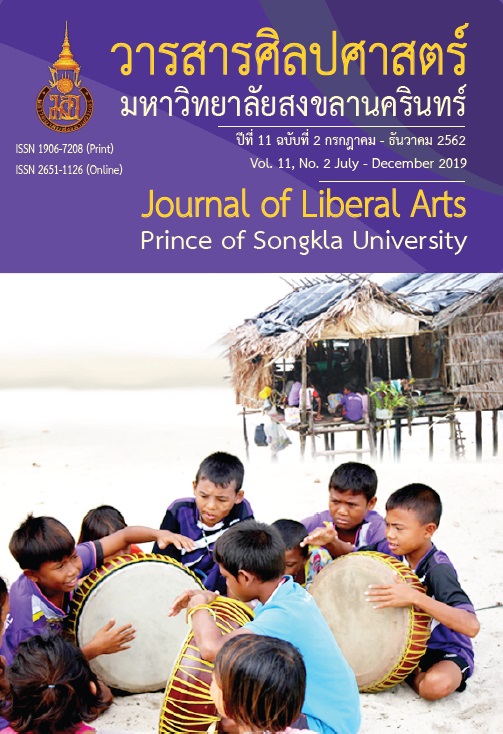The Use of Visual Literacy Strategies to Enhance Reading and Critical Thinking Abilities
Keywords:
Visual literacy, visual literacy strategies, reading ability, critical thinking, thinking abilityAbstract
This research aimed to study the effectiveness of using Visual Literacy Strategies (VLS) to enhance reading and critical thinking abilities. Eighty Mathayomsuksa Four students participated in this study; 40 students formed an experimental group and 40 students were in a control group. Visual Literacy Strategies were practiced in the experimental group whereas an instruction based on the school’s reading curriculum was taught in the control group. The experimental instruments included 10 VLS lesson plans each comprising 10 reading texts and activities. A reading test, used as the data collection instrument, consisted of two reading texts and each had 12 questions based on Bloom’s taxonomy of critical thinking level (1956). Percentages, means, standard deviations and t-test were employed in the data analysis.
It was found that the level of reading ability of the experimental group increased significantly at the level of .01, signifying that using VLS yielded positive results. A further comparison also showed the significant differences between the two groups, making it fair to say that VLS is highly effective. Regarding the critical thinking ability, the experimental group could improve their critical thinking ability significantly at the level of .01. Results from the comparison between the two groups indicated the higher scores in the VLS group with the significant differences in the progression of all levels of critical thinking, except level three (application), in which there was no significant difference.
References
Alberto et al. (2007). Components of visual literacy: Teaching logos. Focus on Autism and Other Developmental Disabilities, 22(4), 234-243.
Bamford, A. (2003). The visual literacy white paper. Australia: Adobe Systems Pty Ltd.
Bloom, B.S., et al. (1956). Taxonomy of educational objectives handbook I: Cognitive domain. New York: David Mckay Company, Inc.
Buaprasertying, P. (2007). Use of mental imagery strategies to promote English reading comprehension and creative writing ability of English program students. (Master thesis, Chiang Mai University). [in Thai]
Carry, D. (2003). Visual literacy: Using images to increase comprehension. Retrieved March 1, 2017, from https://readingrecovery.org/images/pdfs/Conferences/NC09/.
HandoutsChotwattanachai, R., Viboonrungsan, S., & Prachanban, P. (2015). The development of instructional packages through DR-TA teaching strategy to promote concept in English reading for Matthayomsuksa 4 students. Journal of Education Naresuan University, 135-145. [in Thai]
Krashen, S. D. (1982). Principles and practice in second language acquisition. New York: Prentice Hall.
Mongkonsing, K. (2005). Use of mind-mapping to enhance English writing skills of Prathom Suksa 5 students. (Independent Study, Chiang Mai University). [in Thai]
Northridge, K. (2014). Measure critical thinking skills. Retrieved February 1, 2017, from https://www.ehow.com/how_5864397_measure-critical-thinking-skills.html.
O-manee, A., & Charumanee, N. (2016). The use of extensive reading activities to develop English reading competency and critical thinking ability. Journal of Liberal Arts Prince of Sonkla University Hat Yai, 8(2), 104-131. [in Thai]
Pettersson, R. (1989). Visual for information. New Jersey Educational Technology Publications.
Raynolds, A. (1994). The global learning organization. New York: Irwin.
Sangkom, P. (2006). Visual literacy activities and practice. Retrieved March 1, 2017, from www.drsangkom.com. [in Thai]
Seenuan, T., Phonyotin, P., Sangprateeptong, V., and Tulananda, O. (2018).
A development of an instructional model to develop early childhood critical thinking through reflective teaching and documentation.Journal of Education Naresuan University, 20, 61-74. [in Thai]
Su-ya-ai, K. (2009). Using Visual Thinking Techniques to Promote English Reading and Creative Writing Abilities of Undergraduate Students. (Master thesis, Chiang Mai University). [in Thai]
Walsh, M. (2003). ‘Reading’ pictures: what do they reveal? Young children’s reading of visual texts. Reading, 3, 123-130.
Wright, A. (1989). Pictures for language learning. Cambridge University Press.
Yenawine, P. (1997). Thoughts on visual literacy. Retrieved March 1, 2017, from https://vtshome.org/wp-content/uploads/2016/08/12Thoughts-On-Visual-Literacy.pdf.
Yi, C. P., & Yi, C. P. (2009). The effects of pictures on the reading comprehension of low-proficiency Taiwanese English foreign language college students: An action research study. VNU Journal of Science, 25, 186-198.
Zambo, D. M. (2009). Using visual literacy to help adolescents understand how images influence their lives.Teaching exceptional children, 41(6), 60-67. Ennis, R.H. (1985). A Logical Basis for Measuring Critical Thinking Skill. Education.
Downloads
Published
How to Cite
Issue
Section
License
The authors retain the copyright to their article but the Journal of Liberal Arts, Prince of Songkla University reserves the exclusive rights to first publication.






